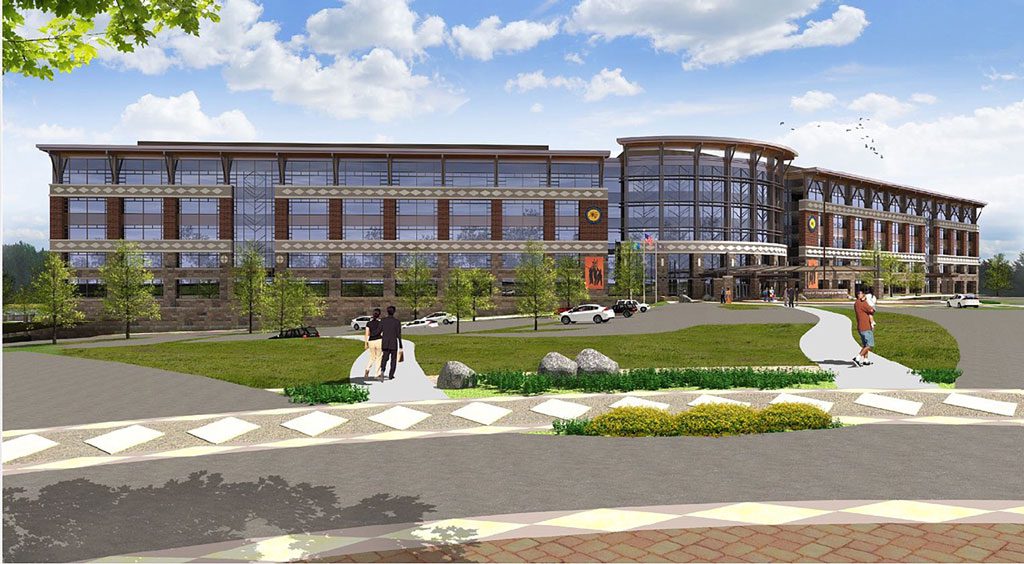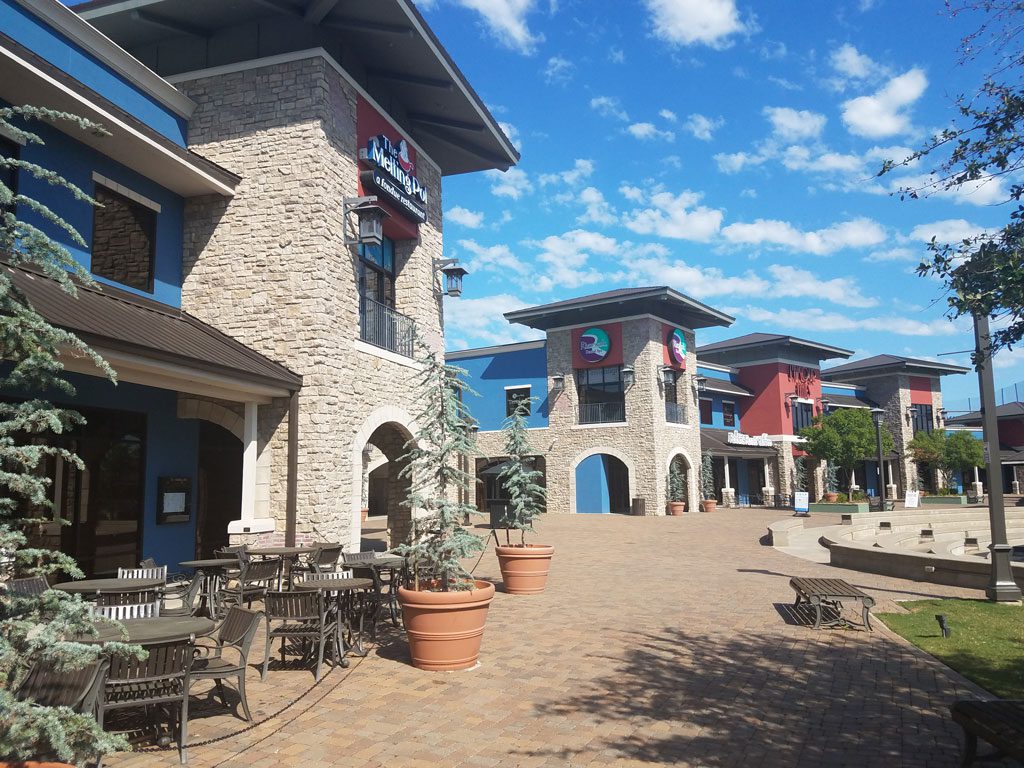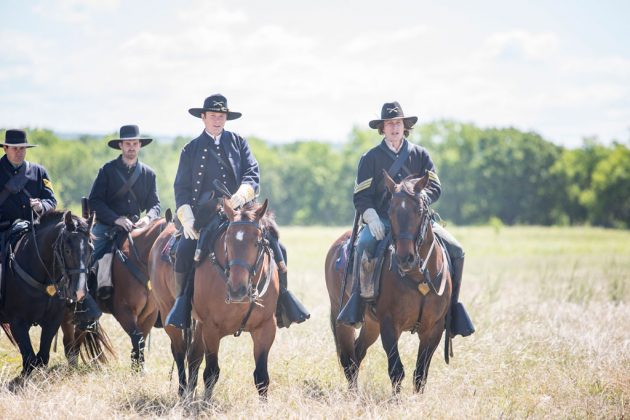
With new facilities to address health care needs, new educational buildings and programs, or new places and sources for recreation, Native Americans in Oklahoma are on the move. While not an exhaustive, this report highlights some recent development by five of the state’s tribes, which provide expanding benefits for their members and Oklahoma as a whole.
Muscogee (Creek)
Improvements from the Muscogee (Creek) Nation line the west side of the Arkansas River in Jenks’s RiverWalk Crossing, where shopping, eating and golf (at the Flying Tee) abound. Across the 96th Street bridge and just north on Riverside Parkway in Tulsa, luxurious lodging is found at River Spirit Casino Resort, with its Paradise Cove and Las Vegas-style pool. While all of this may sound like simple fun and games, there is a solid foundation for Muscogee investment in these venues.
“Monies generated from these ventures allow the Nation to give back to the state and local governments, school, communities, businesses and most of all, the Muscogee (Creek) citizens,” says T. Geebon Gouge, the tribe’s director of public relations.
The River Spirit Casino Resort has expanded in recent months. Jimmy Buffett’s Margaritaville Casino and Restaurant opened there in 2016, effectively expanding the establishment by 50,000 square feet and creating two casinos in one. There are a variety of dining options, hundreds of hotel rooms, a convention center and a theater.
The Muscogee have invested in the RiverWalk Crossing and River Spirit through Onefire Holding, a wholly owned subsidiary of the Muscogee Nation. Dividends to the tribe and Oklahoma roll in.
“We are building a stronger future for the Muscogee (Creek) Nation by providing employment opportunities and creating additional revenue that empowers tribal citizens through additional funding for health services, education and governmental functions,” says Mike Payne, CEO of Onefire Holding.
Cherokee
The Cherokee Nation has broken ground on a 470,000-square-foot outpatient facility in Tahlequah. The benefits to Cherokees and to Oklahoma are numerous.
“It will be the largest and most advanced health care facility in all of Indian Country and will be an excellent addition to health care options in northeast Oklahoma,” Cherokee Nation Principal Chief Bill John Baker says.
The facility will sit on the campus of W.W. Hastings Hospital, which has run over capacity for a while. The site was home to 400,000 patient visits last year in a building meant to see only 100,000 per year. The new health center will provide Cherokees with better, faster services and reduce out-of-system referrals by providing onsite specialists.
The Cherokee Nation anticipates the center will bring more than 800 health care jobs to the area and 350 construction jobs. And according to Baker, the local economy will benefit due to an increase in activity, traffic and an influx of residents and visitors.
“New jobs, shorter wait times and better services will positively impact so many lives in northeast Oklahoma. This is an absolute game changer toward a better and brighter future,” he says.

Photo courtesy the Choctaw Nation
Choctaw
The Choctaw Nation keeps up with tribal development trends with a range of projects designed to serve its members. These include new Head Start program early learning centers, child-care centers, casino expansions, and new medical and office buildings. According to the tribe, at the beginning of 2017, 40 tribal projects were underway in southeast Oklahoma, bringing jobs and growth.
Providing more easily accessed services is important to the Choctaw. Many tribal offices are spread throughout Durant, but, in a few months, they will all be brought together in a 500,000-square-foot, five-story headquarters. About 1,500 employees will relocate there to provide a central location for many Choctaw services.
“The Choctaw Nation was looking to create synergies for our tribal members by allowing them a central location for all service offerings within the Bryan County area. It will also bring all of our employees together to allow for better collaboration and service delivery,” says T.R. Kanuch, senior executive officer of the Choctaw Nation of Oklahoma Division of Commerce.
Earlier this year the tribe opened its Choctaw Nation Regional Medical Clinic, which includes three buildings and 174,000 square feet and sits on the same 130-acre campus as the soon-to-be headquarters. The clinic has the capacity to serve 7,000 Choctaws per year and includes, among other improvements, an MRI machine, allowing patients to stay in Durant for testing.
Choctaw Chief Gary Batton writes in a recent article: “The Choctaw Nation has more to offer than ever before. The increase in job opportunities provides incentive to live and work in our area so that our people are empowered to provide for themselves and their families.”
Chickasaw
One way the Chickasaw Nation focuses on sharing its rich heritage is cinematically. The Chickasaw Rancher is the latest project for Chickasaw Nation Productions, which, according to its website, “shares the enduring legacy, culture and heritage of the Chickasaw people through documentary and feature film.”
The Chickasaw Rancher focuses on Montford T. Johnson, a Chickasaw with humble beginnings who owned and ran multiple ranches in central Oklahoma. Johnson honored his heritage by conducting business in a manner respectful to native people in the area; he was known for his charity and philanthropy toward suffering Native Americans and orphaned children.
The tribe’s films tell part of the story of Native people in general and the Chickasaw in particular to audiences who might not otherwise know them.
“We believe sharing this story of [Johnson’s] strong Chickasaw spirit will enable us to expand on his legacy and develop an even stronger sense of community,” Chickasaw Nation Governor Bill Anoatubby says.
The Chickasaw Rancher illustrates the story of the Chickasaw Nation, says Anoatubby, adding that Johnson overcame difficult times and adversities to achieve success.
“This is a perfect story to tell about the Chickasaw Nation,” he says.
Osage
The Osage Nation has projects in progress, including a $150 million improvement to its casino in north Tulsa and developing the recently purchased Bluestem Ranch, but Principal Chief Geoffrey M. Standing Bear stresses the importance of his tribe’s educational efforts.
“The way of economic development is through education and health,” says Standing Bear, adding that the Osage Nation focuses on what will make its members healthier, more secure and more educated.

The tribe has long supported members’ post-secondary educational efforts through scholarships, and the youngest members of the nation can attend the Wah-Zha-Zhi Early Learning Academy to give them a strong educational start while their parents go to work.
Perhaps the educational effort that most promotes the Osage people is the Language Immersion School (or Daposka Ahnkodapee, Our School, when translated from the Osage language), founded in 2015. The school provides an environment where youngsters can hear and speak the Osage language from early ages. The school serves children from six weeks to first grade with plans to expand all the way through high school.
“The benefit [of the immersion school] to the Osage Nation and its members is the educational opportunities it provides for the youth of the Osage Nation, along with the school’s core mission of language preservation and revitalization,” says David Webb, the school’s headmaster.


























